PARISH OF ST. PAUL'S, SHANKILL
by Kieran Clendinning
The saying, something old, something borrowed,
something new, can in many ways be applied to the new Lurgan parish
implemented by the Most Rev. Dr. Gerard Brooks, for the development and
rearrangement of the Diocese of Dromore to meet the spiritual challenges
for the "cure of the souls" in the third Christian millennium.
At first it was hard to evaluate the reception to the
new parish as the constancy of the people's faith centred around the
life of St. Peter's - the mother church of Shankill - St. Paul's being a
new church erected in 1966 as a chapel-of-ease. This was planned to
accommodate the extensive urban housing development in the districts of
Shankill and Tagnevan. However, in 1992, the confirming of the status of
a parish church on St. Paul's, and the appointment of the Very Rev.
Francis Molloy as P.P. engendered a feeling of achievement that
developed into a sense of pride among the Catholic families in the
greater Edward Street, Francis Street, Shankill Street districts of the
town.
DEDICATED PASTOR
While many people, both clergy and laity have
contributed to the foundation of a second parish, the main thrust for
the foundation of a new church began in the 1950s under the influence of
the late Very Rev. Mgr. Edward Campbell. A figure of importance in
diocesan ecclesiastical affairs, and efficient parish management, Mgr.
Edward Campbell. was appointed P.P. Shankill on the 20th. March 1955.
During the early period of his assignment to Lurgan, the pattern of
education changed considerably under several government proposals. Since
Lurgan was a major growth area with a large rural population, the
newly-appointed parish priest was faced with the necessary, but enormous
financial task of implementing a major school-building programme.
In October 1955, a site for a new Girls Intermediate
School at Kitchen Hill was acquired from the Sisters of Mercy. On the
12th. January 1959, Most Rev. Dr. Eugene O'Doherty, the Bishop of
Dromore, at a ceremony attended by the Mayor and Town Clerk of Lurgan,
with representatives of the Ministry of Education, blessed the complex
and formally named St. Mary's. As this project was being completed,
plans were being formulated for the purchase of an eight-acre field in
Francis Street as the site for the St. Paul's Intermediate School
complex. Work began here in 1959. However, at the early stages of
construction, veins of "running sand" caused major problems, resulting
in excavations to a depth of 20ft. to find solid footings. Building work
progressed until mid-1962. The school received its first pupils in
September 1962, with Mr. Thomas Keville as principal, and Mr. Gerard
McCrory as vice-principal.
The building of a new church to meet the needs of a
rapidly increasing population became a priority of Monsignor Edward
Campbell. However, from his appointment as pastor of Shankill, Mgr.
Campbell, had worked so very hard to accomplish the educational needs of
the parish, including relocation St. Peter's Primary School to William
Street, and build three new schools - St. Teresa's Halftown, St. Mary's,
and St. Paul's - the worry of this huge and costly undertaking seriously
affected his health. This situation was compounded when major structural
complications arose during the construction of St. Paul's Church. The
mental stress sustained at this period by the now-ailing parish priest
in no small way contributed to his untimely death on the January 9th.
1964.
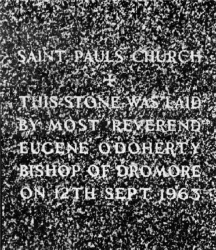
Foundation stone of
St. Paul's Church laid by Most Reverend Dr. Eugene O'Doherty,
Bishop of Dromore, on September 12th. 1963. The 40th.
anniversary of the event was the occasion of a group of
memorable events organised by Father Gerard Powell, P.P. and
Father Desmond Mooney, C.C., among which was the awarding by the
Pope of the Bene Merente medal to Mrs. Ethna McLoughlin, church
organist for forty years, and to Mr. Benedict Lavery, stalwart
in the St. Vincent de Paul Society for more than fifty years.

The Very Rev. James Haughey, a native of Aghaderg;
succeeded Mgr. Campbell as P.P. Shankill. 1st. April 1964, and arriving
in Lurgan found that he had been appointed Vicar General. He later
received a Papal elevation as a Domestic Prelate by Pope Paul in
December 1976. Arriving in Lurgan, he immediately became involved in
negotiations to get a new contractor for the completion of the new
church of St. Paul's. In May 1964, Gilbert-Ash of Warrenpoint, were
appointed main contractors, and work progressed steadily until the
scheme was completed. The first Mass was said in St. Paul's on the
Fourth Sunday of Advent 1965, and was officially consecrated amid great
celebrations some month later. The official opening of St. Paul's Church
was carried out amid splendour and dignity on Low Sunday 1966. Arriving
in Lurgan, the Primate, His Eminence Cardinal Conway, Archbishop of
Armagh, was accorded a Liturgical reception at St. Peter's, North
Street, after which he was taken in a cavalcade of cars to the new
church, through streets of the town decorated with Papal flags, bunting
and banners. Arriving at Francis Street, the Cardinal was received at
the entrance to the new church by the parish priest, Rt. Rev. Mgr.
Haughey.
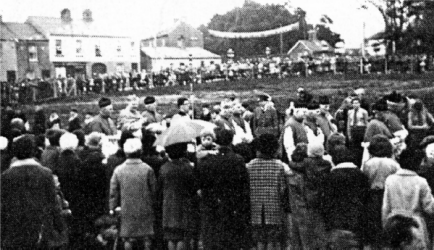
Low Sunday, 1966:
Following the Canons of the Dromore Diocese in procession are
Cardinal Conway, Monsignor Haughey and Dean Mooney, prior to the
official opening of St. Paul's Church. Parishioners gathered in
great numbers for the important occasion. All the buildings in
the background and many more have disappeared as the district
was completely redeveloped.
The dedication centred on the Solemn Mass, with the
Cardinal Archbishop Conway, presiding. The celebrant of the liturgy was
the Very Rev. J. P. Burke P.P. Clonduff, assisted by the deacon, Rev.
Rory McKee, St. Patrick's College, Maynooth, and sub-deacon, Rev. Gerard
McCrory, St. Patrick's College, Carlow, - all three being natives of
Lurgan. The Master of Ceremonies was Rev. P. Smyth C.C. Shankill. In
addition to Most Rev. Dr. O'Doherty, Bishop of Dromore, two other
bishops were in attendance, the Most Rev. Dr. McFeely, Bishop of Raphoe,
who preached an emotive sermon dwelling on the poignancy of the
occasion, and Most Rev. Dr. Philbin, Bishop of Down and Connor.
Assisting the Cardinal were the Rt. Rev. Mgr. Haughey P.P. V.G.
Shankill, and the Rt. Rev. Dean Mooney, P.P. Seagoe. Among the large
number of clergy in the sanctuary were the Rt. Rev. Mgr. P.J. Mullally
V.G. Down and Connor; Rt. Rev. Mgr. J. Quinn, P.P. V.G., Dungannon; Very
Rev. Mgr. T. Boyle, P.P..; Kilbroney; Very Rev. T. Canon Pettit, P.P.,
Tullylish; Very Rev. A. Canon McMullan, RR, Dromara; Very Rev. E. Canon
Rice, P.P., Portadown; Very Rev. R. Wall, O.P. Prior of St. Catherine's,
Newry; and the Rev. John McAnuff, President of St. Colman's College,
Newry.

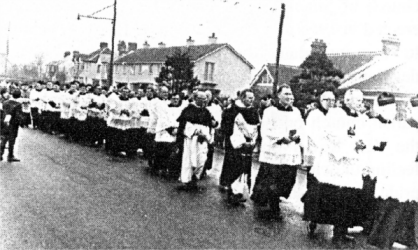
Part of the
procession of priests in Francis Street, Lurgan, on their
way from vesting in St. Paul's School to the Ceremony of
Blessing and Dedication of St. Paul's Church, on Low Sunday
1966. Four local priests, viz. Fr. Jim Kerr, Fr. Eddie
O'Connor, Fr. Sean Lavery and Fr. Oliver McStravick, are in
the centre of the photograph, directly behind the Order
priests.
St. Paul's was one of the first of the new generation
of Catholic churches, with a non-traditional grey plasterwork exterior
finish and a distinctive copper roof and slim tower. At either side of
the atrium or entrance were added two hexagonal rooms, each with a
separate entrance; the room to the right was to be the baptistry, that
to the left, the mortuary. However, the middle of the 1960s was to
witness great changes in the approach to public worship in Catholicism;
the mortuary was seldom used as the then recent practice of bringing the
remains of the deceased to church on the evening before the Requiem Mass
disappeared almost as quickly as it had been introduced. The new
guidelines for the Rite of Baptism which emerged during and after the
second Vatican Council decreed that those seeking Baptism were no longer
to be regarded or treated as catechumens and restricted to the very rear
of the church, the traditional location of the baptism font. Instead,
all baptisms were to be administered at the front of the church adjacent
to the sanctuary, Thus, a new and almost unique feature of St. Paul's
Church, viz. a special room for baptisms, was in practice seldom used.
In comparison with older urban Catholic churches, the
interior of St. Paul's Church is quite plain; decorative mosaic was not
used except in facing the many slender pillars and then only in
monocolour pattern. The long broad mahogany seats were carved locally.
The large carved crucifix which hangs above the altar was a present from
the parish priest, Monsignor James Haughey. The local Sisters of Mercy
donated the ornate altar to the parish and the large black and white
plaster tabloid depicting the motto of Saint Paul, IMITATORES MEI ESTOTE,
which is located above the church entrance door, was a present from the
architect.


Large impressive black-and-white Coat-of-Arms of
Saint Paul adorns the front exterior of St. Paul's Church, Lurgan.
Located above the entrance door, the tablet was a present from the
architect, Thomas J. Ryan of Dublin.
Many other items of liturgical and furnishing
importance were gifts from individuals and associations within the large
and populous parish of Shankill. It may well be that St. Paul's was the
first if not the only Catholic church within the region at the time of
its construction to have only one altar; it was traditional for all
Catholic churches, large and small, to have three altars at the front of
the church, viz. the High Altar for the day's main worship, and two
`side altars', for additional worship, one dedicated to the Sacred Heart
of Jesus, and the other dedicated to the Blessed Virgin Mary.
Since its opening, St. Paul's Church has helped many
to attend Mass often with little inconvenience and the steady stream of
the faithful who make frequent daily visits emphasises the correctness
of the siting of the new church. The site was donated to the Parish by
Miss Emma Donnelly, a lady whose life was full of
good Christian deeds. The parish's clerk-of-works,
Eddie Hamill, who gave great service during the building of the church
and local schools, died shortly after St. Paul's was opened. The choir
associated with St. Paul's, under the direction of Mrs. E. McLaughlin
(organist) is surely one of the riches of the parish.

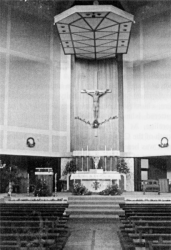
The interior of St. Paul's
Church, Lurgan.
Over the next sixteen years, St. Paul's remained a
chapel-of-ease. However, on Friday 4th. September, 1982, the sacred
structure was raised to the dignity of a Parish Church, and the ancient
parish of Shankill was divided into two separate communities. The
parochial administration encompasses Annaloiste, Boconnell, Knockramer,
Silverwood, Shankill, Taghnevan, Tannaghmore South, Toberhewey
Aughnacloy, Tiersogue, part of Lurgan, Drumnakelly, Ballyblagh, Dougher,
Knocknashane, Derry, Turmoyra, and part of Ballinamoney and Moyraverty.
The parish was sub-divided by drawing a straight line through Lurgan
town from `Blough to Lough Neagh' rather than circumscribing several
townlands to denote the boundary between the two new parish entities.
However, there is no diversity in the alliance of each church to
identify with Shankill's ancient past. In fact the adjustments in the
subdivision of the parish has meant that St. Paul's, has acquired -
within its allotted proportions of townlands - the early foundations of
the medieval church of Shankill and the still earlier lough-side Termon
lands of Kilwilke; at Oxford Island.
While it is claimed that the See of Dromore owes it
origin to Colman or Colmoc, information regarding the church at Kilwilke
situated in the north-west corner of the diocese is sparse. This
foundation occupied part of the lands of Clann Breasil, a territory
lying east of the river Bann that was virtually coextensive with ancient
parishes of Seagoe and Shankill. The presence of such a large sheet of
water such as Lough Neagh played an important part in the development of
the Christianity in central Ulster. Here, church communities were
established on the scattered islands and fenlands around the lough
shoreline. At Annaloiste, "the low island," at the mouth of the Closet
River, provided good anchorage, and it was here on the highest point on
the island the settlement of Kilwilke was established. It is also more
than a possibility that before any church was first built the Christian
site was marked with a cross within an adjacent burial place. The cross
being an open air assembly place where the sacraments and other rites of
the church were administered by itinerant missioners who had come to
preach from monastic settlements on the far side of the lough such as
Ardboe, in Co. Tyrone, or from Cranfield, in Co. Antrim.
COARBS AND ERENAGHS
It is unlikely that stone would have been used in the
building of the church at Kilwilke as the small community would have had
to make the best use of the material available. In the well wooded area
now known as Oneilland East, the first church would have been wholly or
partly built with oak timber. In its elementary form, the structure
would have been a simple two cell structure needed for the provision of
an altar and shelter for the small community. Except for a few lines in
Pope Nicholas taxation roll there is no documentary information relating
to this early foundation or the role of the church in the lives of the
local community. However it is possible to glean an insight into the
social and spiritual implications of a settlement such as Kilwilke from
the writing of scholars of the subject. From the earliest times, the
church gravitated towards monasticism and operated under the laws of
Tanistry and while it was episcopal in matters of higher spiritual
functions such as ordinations, it was structured and administrated by a
system of Coarbs and Erenaghs. Most of the Irish ruling families granted
permission for churches or
monasteries to be built, but only on the strict
condition that the family maintained their interest in the land and that
the important appointments within the establishment were held by their
kin. Under these terms the line of succession rested with the donor's
family. The order or title of Coarb derives from "comhabra" and is best
described as heir or successor in relation to the founder of the church.
The title, Airchinneach, Erenagh, a member of the ruling family and who
in many cases was not in Holy Orders, acted as the head or superior and
was entitled to appropriate the income of the church or monastery. Both
Orders were the mainstay in finance and administration but their
privileges and duties varied from district to district. There were also
other duties imposed by Tanistry on the church; these included the
maintenance of church property and houses of hospitality. These
dwellings were sited on Termons, inviolable boundary lands that
benefited from the Irish laws of precinct.

PAROCHICLS DE KYL-MILCON
Under the aegis of the Gregorian reform movement the
community residing in the newly-formed parish system such as Kilwilke,
were subjected to the authority of the Bishop of Dromore, and owed a
duty to attend the church and, as far as their means permitted,
contributed to the church expenses. The parochia of Kilwilke was still
in existence at beginning of the 15th. century. In 1411, Patrick Mcgwyry
(McGivern) is recorded as having been appointed as the "Rector Ecclesiae
Parochiclis de Kyl-milcon." Again, in 1431, the title, Canoncatius et
Pranda St. Kintanide Kyllmicon, ails Caill more", was conferred on
Tatheus Mcgwyryan" with its accompanying stall in the choir of the
Chapter of Dromore, left vacant by the death of Donal Oronagh (O'Rooney).
Owing to the small number of people living in the territory of Clann
Breasail, it would appear that the parish system in the area was too
ambitious. Records show that the parish of Kilwilke and Seagoe, "being a
moderate distance of each other and being insufficient for the support
of two priests", were united by the Pope in 1444. This situation lasted
almost 400 years - until the beginning of the 19th. century when
Shankill was re-constituted in 1819.
The first time that the name Shankill appears in any
records occurs is in the Plantation Survey of Armagh, July 2nd. 1608.
The principal aim of the survey was to define the area of temporal and
ecclesiastical land. Among the names of the jury were Cabery McCann and
Patrick oge O'Cor. The inclusion of Cabery McCann as a juror,
particularly in the search and title of church lands is interesting. In
the maps prepared for the county in 1609, the name, Rowri me Patrick
McKan, is written across Clann Breasail; this shows that the McCanns
were regarded as chieftains of this territory at the time of the
confiscation. This suggests that Cabery McCann, may have been the Ernagh
of Kilwilke. However, be that as it may, the survey, in dealing with the
Termon lands, found that that there was "a chapel of Shankill belonging
to the Church of Kilmulchan ", and appears as a roofless structure on
the map of 1609. A scrutiny of the map reveals a flaw as the
cartographers failed to include the townland of Annaloiste and made no
reference to the church at Kilwilke. Could the reason for this failure
to show Kilwilke on the map be the non-compliance of Cabery McCann as
Ernagh? When questioned at Moyry Castle, he may have deliberately held
back evidence relating to his Termon lest his lands would be forfeited
to the Reformed church then being newly-established under the terms of
the Ulster Plantation. Papal records also show that Shankill appears in
a Papal document dated March 29th. 1609, granting Hugh O'Neill, then in
exile in Rome, the right to nominate the rector of the united parishes
of Shankill and Seagoe. A few years later, another reference to Shankill
appears in State records dealing with the Anglican establishment for the
year, 1622. Since that time, Shankill has been the accepted title of the
parish of both the Catholic and Anglican Church in Lurgan.

CONVENT OF MERCY
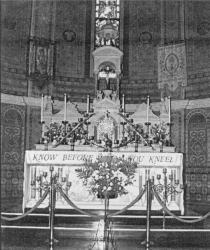
The very beautiful
Sanctuary of the Adoration Chapel, Edward Street, Lurgan,
formerly the Convent of Mercy Chapel. This chapel and the
Convent of Mercy Chapel, in Catherine Street, Newry, are most
fitting places of worship, their splendid and refined interiors
reflecting the highest ideals of church architecture.
The division of Shankill has meant that the Convent
of Mercy in Lurgan is in the parish of St. Paul's. To try and compress
into a very limited space the record of the community in well nigh
impossible. Before the Convent schools were established in the town, the
only school for girls was in a sparsely furnished room in the old
disused mill in the Dougher. In 1865, acting on behalf of then R.P.,
Very Rev. James McKenna, a member of the Magee family of Union Street,
purchased land in Edward Street for a convent and it was ready for
occupation the following year. The Rev. John McConville, a curate at
Shankill, played a notable part in bringing the teaching order of nuns
to Lurgan. The nuns, Mother Emmanuel Russell and six Sisters, arrived
that August and almost immediately turned part of the convent into a
school.
By 1875, the community fully introduced a educational
programme which continued well into the 1950s. This began with the
building of the Edward Street schools. Later the purchase of the large
property in Church Place in 1887, was followed, in 1888, by the
construction of the House of Divine Providence, at Cornakinnegar, and
with the building of the Sacred Heart School for Girls in the 1890s.
Moving into the 20th. century, the property known as Irishtown House was
purchased and used for a variety of educational uses. During the 1920s,
the house was up-graded and extended and developed as a Secondary
boarding school and renamed St. Michael's as a tribute to the work of
the Very Rev. Michael Blake McConville P.P., 1897-1925, who worked so
zealously with the Sisters of Mercy in their unstinting labour in the
promotion Catholic education for girls in the Parish of Shankill.

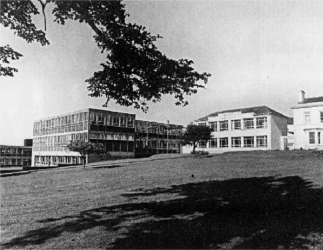
Part of
the extensive campus of St. Michael's Grammar
School, which serves the many parishes surrounding
Lurgan for second-level coeducation for students
aged 14 years and upwards.
The affirmation of Bishop Brooks installing the Very
Rev. Francis Molloy as the incumbent of the newly-founded Lurgan parish
proved to be most effective, for not only did the new parish priest
conspicuously exhibit spiritual guidance in the "cure of souls," but
proved to be an exemplary parish administrator. A native of Ardara, Co.
Donegal, he was educated in St. Peter's College, Wexford, and ordained
3rd. June 1956, for the Diocese of Paisley in Scotland. His clerical
career in Dromore began 1st. February, 1960, with his appointment as
curate in Loughbrickland. Four years later he was appointed to the
Craigavon area. He was a curate in Shankill from 1964. Sixteen years
later he moved to Moyraverty, in January 1980, where he remained as
curate until his appointment as the new P.P. of St. Paul's, Shankill, in
September, 1992. Fr. Molloy retired in April, 2001.
Very Rev. Gerald Powell, P.P. Drumgath,
succeeded to St. Paul's Shankill, in September 2001. A native of Newry,
he was educated at St. Colman's College, and then in the Irish College,
Rome. He was ordained in Newry Cathedral by Most Rev. Dr. E. O'Doherty,
on 9th. April 1972, after which he returned to Rome to complete his
studies. Like his predecessor, Rev. Powell was no stranger to the area
having been being appointed C.C. Moyraverty, 13th. September 1972. His
first contact with St. Paul's came when he was appointed C.C. Shankill,
18th. November 1977, and went to live in the newly-purchased residence
in Taghnevan, for curates attached to St. Paul's. In August 1989, he was
transferred to Warrenpoint as C.C. Clonallon. On the 17th. September
1998, he was appointed P.P. Drumgath, and in the following year, was
appointed Chancellor of Dromore. Very Rev. Powell was appointed P.P. St.
Paul's, 14th. September 2001, and Financial Administrator of the Dromore
Diocese, 21st. July 2003.
The assistant priests in the new parish of St.
Paul's, Shankill, have provided great spiritual leadership for the
heavily-populated district. Fr. Brian Brown and Fr. Colour Wright worked
as a most effective team until 1996, when they were replaced by two
Newry-born priests, Fr. Ian Coulter and Fr. Tom McAteer. They in turn
moved on, and the present curate is Newry-born Fr. Desmond Mooney.
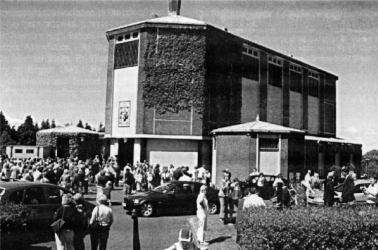
�St. Paul's Church, Francis Street, Lurgan, First Holy
Communion Day, Saturday, 22nd May, 2004.
 |